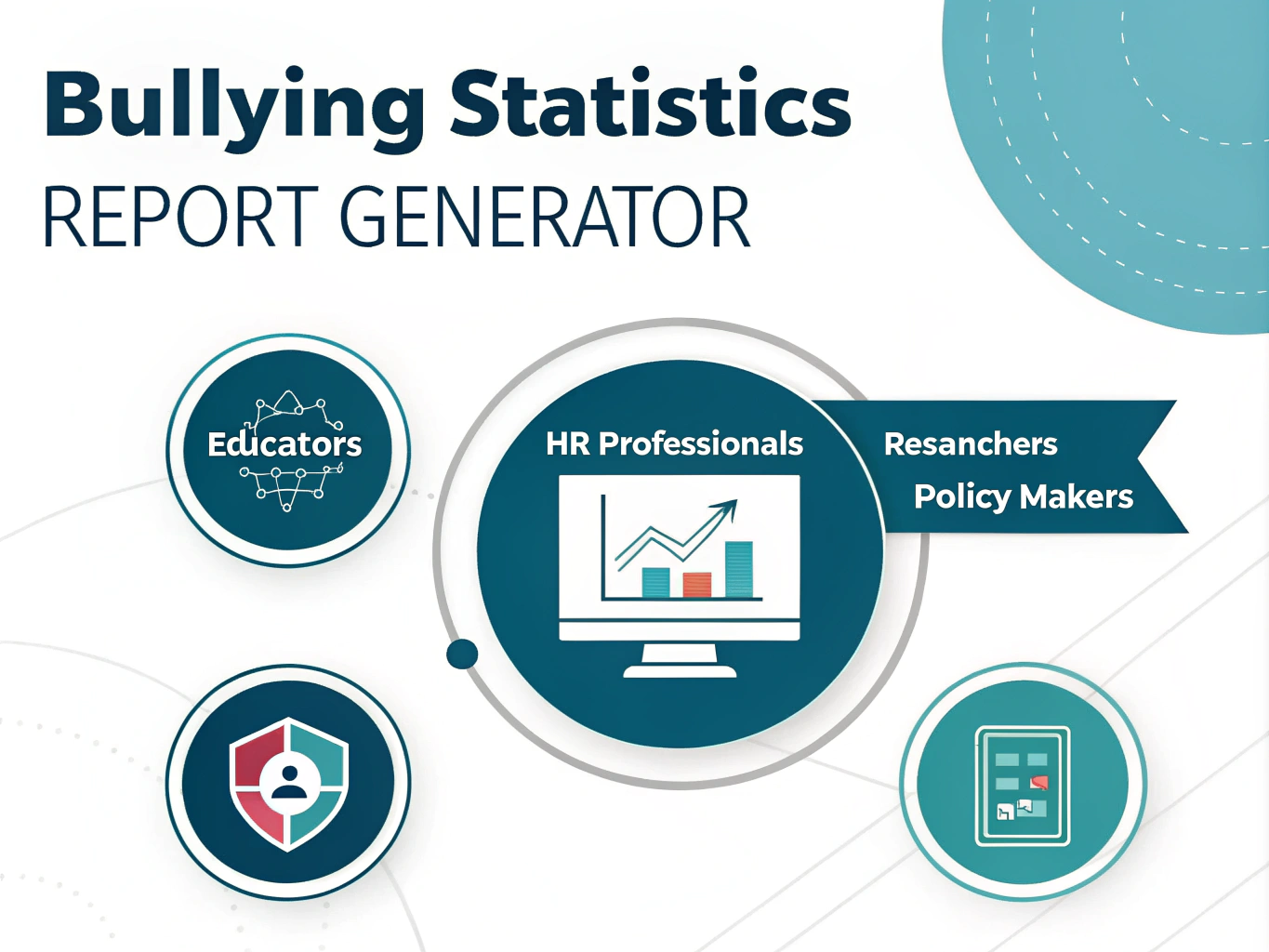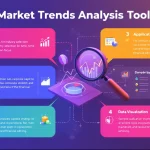Bullying Statistics Report Generator
Generating report...
Is this tool helpful?
How to Use the Bullying Statistics Report Generator Effectively
The Bullying Statistics Report Generator is a powerful tool designed to provide comprehensive insights into bullying incidents across various settings. To use this tool effectively, follow these steps:
- Specific regions or countries: Enter the geographical areas you want to focus on for the bullying statistics. For example, you might input “United States, European Union, and Australia” or “Global statistics with a focus on developing countries.”
- Time period: Specify the time range for which you need bullying statistics. You could enter “2015-2023” or “Last decade” to get a comprehensive overview of recent trends.
- Specific settings: Indicate the environments you want to analyze for bullying incidents. For instance, you might enter “High schools and corporate offices” or “Elementary schools, middle schools, and online platforms.”
- Demographic groups (Optional): If you’re interested in specific demographic information, enter the relevant details. For example, “Teenagers aged 13-18” or “LGBTQ+ individuals in the workplace.”
- Generate report: Click the “Generate Bullying Statistics Report” button to receive a tailored report based on your inputs.
Once the report is generated, you can review the information provided and use the “Copy to Clipboard” button to easily share or save the data for your anti-bullying and stress management initiatives.
Understanding the Bullying Statistics Report Generator: Purpose and Benefits
The Bullying Statistics Report Generator is an innovative tool designed to provide up-to-date, comprehensive information on bullying incidents across various settings and demographics. Its primary purpose is to equip individuals, organizations, and policymakers with accurate data to inform anti-bullying initiatives and stress management programs.
Key Features and Benefits
- Customizable Reports: The tool allows users to tailor their search for bullying statistics based on specific regions, time periods, settings, and demographics.
- Comprehensive Data: By aggregating information from multiple reliable sources, the generator provides a holistic view of bullying trends and patterns.
- Time-Saving: Instead of manually searching through numerous databases and reports, users can quickly generate a consolidated report with relevant statistics.
- Data-Driven Decision Making: The tool enables educators, employers, and policymakers to make informed decisions based on current and accurate bullying data.
- Trend Analysis: By allowing users to specify time periods, the generator facilitates the identification of long-term trends in bullying behavior.
- Cross-Cultural Insights: The ability to focus on specific regions or countries allows for cross-cultural comparisons and tailored intervention strategies.
The Importance of Accurate Bullying Statistics in Anti-Bullying Efforts
Accurate and up-to-date bullying statistics play a crucial role in developing effective anti-bullying strategies and stress management programs. Here’s why these statistics are so important:
1. Identifying the Scope of the Problem
Bullying statistics help quantify the extent of bullying in various settings, allowing stakeholders to understand the true magnitude of the issue. For example, a report generated for U.S. high schools from 2018-2022 might reveal that 20% of students experienced cyberbullying, highlighting the need for digital literacy and online safety programs.
2. Targeting Interventions
By providing data on specific demographics or settings, the Bullying Statistics Report Generator enables the development of targeted interventions. For instance, if the report shows a high incidence of workplace bullying in the healthcare sector, organizations can implement tailored anti-bullying training for medical professionals.
3. Measuring Progress
Regular tracking of bullying statistics allows for the evaluation of anti-bullying initiatives over time. If a school district implements a new anti-bullying program and sees a 30% reduction in reported incidents over two years, it can demonstrate the effectiveness of the intervention.
4. Raising Awareness
Concrete statistics are powerful tools for raising awareness about the prevalence and impact of bullying. Media campaigns, educational materials, and policy proposals can all benefit from accurate, current data to illustrate the urgency of addressing bullying.
5. Informing Policy Decisions
Policymakers rely on accurate statistics to draft and implement effective anti-bullying legislation. For example, if the Bullying Statistics Report Generator reveals a significant increase in cyberbullying incidents among middle school students, it could prompt the development of new online safety laws or educational policies.
How the Bullying Statistics Report Generator Addresses User Needs
The Bullying Statistics Report Generator is designed to address various user needs in the fight against bullying and the management of related stress. Here’s how it caters to different stakeholders:
For Educators and School Administrators
Educators can use the tool to:
- Assess the prevalence of bullying in their specific school type (elementary, middle, or high school)
- Compare local bullying rates to national or global averages
- Identify trends in bullying behavior over time to evaluate the effectiveness of existing programs
- Tailor anti-bullying curricula based on the most common types of bullying reported
Example: A middle school principal in Canada might use the tool to generate a report on bullying incidents in Canadian middle schools from 2020-2023. The report could reveal that while physical bullying has decreased by 15%, cyberbullying has increased by 25%, prompting the school to focus on digital citizenship education.
For Workplace HR Professionals
HR professionals can utilize the generator to:
- Benchmark their organization’s bullying incidents against industry standards
- Identify high-risk demographics or departments within their company
- Justify investments in anti-bullying training and stress management programs
- Track the impact of workplace policies on bullying rates over time
Example: An HR manager in a multinational tech company might generate a report on workplace bullying in the tech industry across North America and Europe from 2018-2023. The report could show that companies with comprehensive anti-bullying policies experience 40% fewer incidents, providing a strong case for policy implementation.
For Researchers and Academics
Researchers can leverage the tool to:
- Quickly access relevant statistics for literature reviews and study backgrounds
- Identify gaps in current research by analyzing trends across different regions or demographics
- Generate hypotheses for new studies based on emerging patterns in the data
- Compare bullying rates across different cultural contexts
Example: A sociologist studying the impact of socioeconomic factors on bullying might use the generator to compare bullying rates in low-income vs. high-income school districts across the United States from 2015-2023. The resulting data could form the basis for a new research project on the relationship between economic inequality and bullying behavior.
For Policymakers and Government Officials
Policymakers can use the Bullying Statistics Report Generator to:
- Assess the effectiveness of existing anti-bullying legislation
- Identify areas where new policies or interventions are needed
- Compare bullying rates across different jurisdictions to inform best practices
- Provide data-driven justifications for budget allocations to anti-bullying initiatives
Example: A state legislator might generate a report comparing bullying rates in their state to national averages over the past five years. If the report shows that their state has consistently higher rates of bullying, it could provide compelling evidence for the need to introduce new anti-bullying legislation or increase funding for prevention programs.
Practical Applications of the Bullying Statistics Report Generator
The Bullying Statistics Report Generator has numerous practical applications across various sectors. Here are some examples of how different stakeholders can use this tool effectively:
1. Developing Targeted School Interventions
Scenario: A school district wants to address a perceived increase in bullying incidents.
Application: The district’s anti-bullying coordinator uses the generator to create a report on bullying trends in their region over the past five years, focusing on different school levels (elementary, middle, and high school).
Outcome: The report reveals that while overall bullying rates have remained stable, there has been a 30% increase in cyberbullying among middle school students. Based on this data, the district implements a new digital citizenship curriculum for grades 6-8 and provides training for teachers on identifying and addressing online bullying.
2. Improving Workplace Anti-Bullying Policies
Scenario: A large corporation is reviewing its anti-bullying and harassment policies.
Application: The HR department uses the Bullying Statistics Report Generator to analyze workplace bullying trends in their industry sector across multiple countries where they have offices.
Outcome: The report indicates that companies with anonymous reporting systems and regular anti-bullying training have 50% fewer reported incidents. The corporation decides to implement an anonymous reporting tool and mandate annual anti-bullying workshops for all employees.
3. Informing Public Health Campaigns
Scenario: A national public health organization is planning an anti-bullying awareness campaign.
Application: The campaign designers use the generator to collect statistics on the most common types of bullying, the demographics most affected, and the long-term health impacts of bullying.
Outcome: The report shows that LGBTQ+ youth are three times more likely to experience bullying, with significant impacts on mental health. The organization creates a targeted campaign focusing on LGBTQ+ inclusivity and provides resources for schools to create safer environments for all students.
4. Guiding Academic Research
Scenario: A psychology researcher is designing a study on the relationship between bullying and academic performance.
Application: The researcher uses the Bullying Statistics Report Generator to gather data on bullying rates in high-achieving vs. low-achieving schools across different socioeconomic areas.
Outcome: The generated report reveals an unexpected correlation between high academic pressure and increased rates of covert bullying. This finding helps the researcher refine their research questions and methodology to explore this relationship further.
5. Supporting Grant Applications
Scenario: A non-profit organization is applying for funding to expand its anti-bullying program.
Application: The grant writer uses the generator to compile recent statistics on the effectiveness of similar programs and the current state of bullying in their target communities.
Outcome: The report provides compelling data showing that communities with comprehensive anti-bullying programs see a 40% reduction in bullying incidents over three years. This data strengthens the organization’s grant application, ultimately securing the funding needed to expand their program.
6. Evaluating Policy Effectiveness
Scenario: A state education department wants to assess the impact of a recently implemented anti-bullying law.
Application: Policy analysts use the Bullying Statistics Report Generator to compare bullying rates in their state before and after the law’s implementation, as well as comparing their state’s trends to those of neighboring states without similar legislation.
Outcome: The report shows a 25% decrease in reported bullying incidents since the law was enacted, compared to minimal changes in neighboring states. This data is used to justify the continuation and potential expansion of the anti-bullying initiatives mandated by the law.
Frequently Asked Questions (FAQ)
1. How often is the data in the Bullying Statistics Report Generator updated?
The generator draws from a variety of reputable sources that are regularly updated. However, the specific update frequency may vary depending on the source and region. Generally, you can expect the most recent annual data to be available.
2. Can I use the generated reports for my own research or publications?
Yes, the reports generated by this tool can be used for research, publications, or presentations. However, it’s important to properly cite the original sources of the data, which will be provided in the generated report.
3. Does the tool provide information on cyberbullying?
Yes, the Bullying Statistics Report Generator includes data on cyberbullying where available. You can specify this as a focus area when inputting your parameters.
4. Can I compare data from different countries or regions?
Absolutely. The tool allows you to input multiple regions or countries, enabling you to generate comparative reports. This feature is particularly useful for cross-cultural studies or global policy analysis.
5. Does the generator provide information on the effectiveness of anti-bullying programs?
While the primary focus is on bullying statistics, some reports may include data on the effectiveness of various interventions or programs, depending on the available research for the specified region and time period.
6. Can I save or share the generated reports?
Yes, once a report is generated, you can use the “Copy to Clipboard” button to easily save the content or share it with others. You can then paste this information into a document or email as needed.
7. Are there any age restrictions for using this tool?
There are no specific age restrictions for using the Bullying Statistics Report Generator. However, given the nature of the topic, it’s recommended that younger users have adult supervision when interpreting the results.
8. Can the tool provide data on specific types of bullying (e.g., physical, verbal, relational)?
Yes, when available, the generated reports can include breakdowns of different types of bullying. You can specify your interest in particular forms of bullying in the “Specific settings” or “Demographic groups” fields.
9. Is the tool accessible for users with disabilities?
The Bullying Statistics Report Generator is designed with accessibility in mind, featuring clear labels and compatible with most screen readers. If you encounter any accessibility issues, please contact the site administrators for assistance.
10. Can I request specific data that’s not included in the standard report?
While the tool aims to provide comprehensive reports based on your inputs, it’s limited to the available data sources. If you need very specific data not covered in the reports, you may need to conduct additional research using the sources provided in the generated report.
By leveraging the Bullying Statistics Report Generator, users across various sectors can access vital information to inform their anti-bullying efforts and stress management programs. This tool not only saves time and resources but also ensures that initiatives are based on current, relevant data, ultimately contributing to more effective strategies in combating bullying and its associated stress.
Important Disclaimer
The calculations, results, and content provided by our tools are not guaranteed to be accurate, complete, or reliable. Users are responsible for verifying and interpreting the results. Our content and tools may contain errors, biases, or inconsistencies. We reserve the right to save inputs and outputs from our tools for the purposes of error debugging, bias identification, and performance improvement. External companies providing AI models used in our tools may also save and process data in accordance with their own policies. By using our tools, you consent to this data collection and processing. We reserve the right to limit the usage of our tools based on current usability factors. By using our tools, you acknowledge that you have read, understood, and agreed to this disclaimer. You accept the inherent risks and limitations associated with the use of our tools and services.







